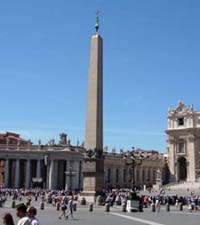 We were talking about festivals and the Washington Monument yesterday (scroll down if you missed this valuable conversation). So I decided to press on with my research into the sacred symbolism of obelisks (tall, four-sided towers than end in a pyramid-shaped point). In ancient Egypt, obelisks paid homage to the all-male, all-powerful, stud sun god Ra. His obelisks united heaven and earth.
We were talking about festivals and the Washington Monument yesterday (scroll down if you missed this valuable conversation). So I decided to press on with my research into the sacred symbolism of obelisks (tall, four-sided towers than end in a pyramid-shaped point). In ancient Egypt, obelisks paid homage to the all-male, all-powerful, stud sun god Ra. His obelisks united heaven and earth.
But here’s where their symbolic value to the world’s religious culture gets interesting: I had forgotten that the obelisk outside St. Peter’s Basilica, the Christian mother church in Rome, was shipped there from the ruins of an Egyptian pagan temple! It seems that history is a tumbling roll of great civilizations appropriating the sacred symbols of the last.
According to this informative web page about the obelisks of Rome:
In imperial times, after the conquest of Egypt, several obelisks were brought to Rome. Others were made by the Romans, who imitated Egyptian hieroglyphics to simulate the real thing…When the Roman empire came to an end, one by one the obelisks fell to the ground and were buried. It was not until the Renaissance that a renewed interest for antiquities caused them to be unearthed. At the end of the 16th century, Pope Sixtus V had the idea of using them as landmarks to guide pilgrims around Rome. In an early attempt at rational town planning, he designed straight streets linking the major basilicas with an obelisk visible from a distance outside each one. [The obelisks were “Christianized” by the addition of a cross on the top.]
The obelisk which now stands in St. Peter’s Square was brought to Rome in 37 A.D., on a huge ship measuring 104m x 20m. The obelisk, which weighs 440 tons, originally stood in Nero’s circus, at the foot of Vatican Hill. Unlike the other obelisks, it remained standing throughout the Middle Ages. In 1585 Sixtus V decided to position it in front of the basilica of St. Peter’s. The complicated feat of engineering, which required 140 horses and 900 men, was accomplished by Domenico Fontana and was recorded in a number of contemporary drawings and a fresco painted in the Vatican Library.
Here’s a long but enthralling paper that quotes (when you scroll down) Theosophy founder Madame H. P. Blavatsky reviewing what sacred obelisk-shaped towers say about the public psyche. The paper additionally reveals that funds for our Washington Monument were gathered in the 1830s by Freemasons (a fraternal organization that had counted George Washington as a member). The pagan origins and lofty aspirations of the tower’s form were not lost on them.
Imagine getting similar architectural plans past the right-wingers in Washington now?! Even if they moved through the pagan part, they’d probably link the monument’s shape to the gay rights movement. Here’s a more serious question for feminists: Is it offensive that a phallus has in essence been our nation’s guide? Or is it just incomplete and half the story, as it were?

